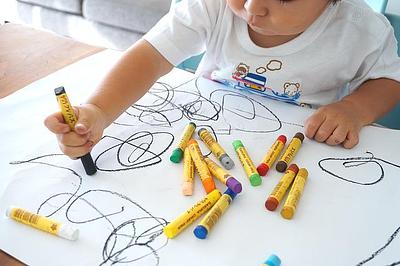Looking for all Articles by Early Years team?
More than just marks on a page: how to start children writing
Learning to write can be complicated, but providing children with lots of mark making experiences through play, songs, rhymes and stories, will help them to build the skills they need.

Although they may look like random marks and scribbles on a page, children’s early writing (sometimes called mark making) is an important path to learning to write and also to literacy development. Learning to write is a complicated process, but the earlier children have the opportunity to play around and see the visual marks they can leave, the stronger their desire to learn to read and write. By making marks they’re able to develop an understanding that marks can convey meaning.
Mark making and starting to write starts before we give children a paper and a crayon. Here are some ways to encourage writing:
Play!
Messy play is a great way to start children off. Let them play with their food and move it around, trace in shaving foam, or paint with their fingers. This is a fun way to help children see the effects of how they move. While they’re having fun playing, and seeing the effects of their efforts, they’re also developing some of the motor skills that are required to learn to write shapes and symbols (like letters and pictures).
Choose books with writing as part of the text
Some books include written letters as part of the text. Look for books like The Jolly Postman or Postman Bear. Pointing out the difference between the text that forms the story and letters in the text, or signs in the illustrations, is a great way to help children recognise different kinds of writing. Pointing these out will help children catch the concept of meaningful print.
Sing and rhyme
Action songs and rhymes are another great way to help children develop the fine motor skills required. Lots of songs and rhymes include concepts of direction. Learning the names for different movements will be required when trying to explain to children which ways to move their pencil to form different letters. If children have a chance to catch positional, or directional language from songs and rhymes, then they will be in a better place to follow the movements when they eventually learn to write. Try Forwards and Backwards or When I was One.
Let your child see you writing
Children love copying and if they see you writing lists and notes, then they’ll start to imitate and copy. You can take the time to point out words that you’ve written, but also ask your child to make their own lists and notes.
Learning to write is an important stage in children’s development. Writing is a vital communication tool and an essential way to give information, convey meaning, exchange ideas and entertain. Learning to write can be complicated, but providing children with lots of mark making experiences through play, songs, rhymes and stories, will help them to build the skills they need.